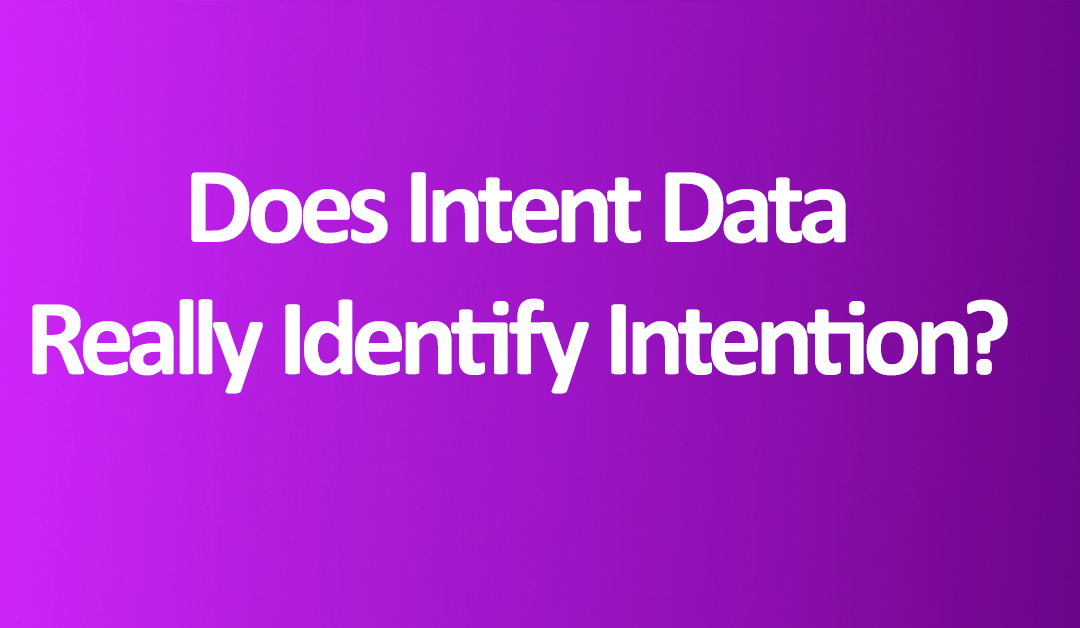Are you getting what you thought you bought?
A survey by Bain and Google of 1,208 people at U.S. companies who are involved in buying software, cloud hosting, hardware, telecommunications, logistics, marketing, and industrial equipment revealed a set of misconceptions among sellers about how buyers behave. Sellers don’t realize that 90% of buyers choose a vendor that was on a short list at the beginning of the sales process; they focus too much on high-level decision-makers, underestimating the number of people inside the buying company who have influence; they rely too much on digital channels, neglecting physical selling; and they don’t realize how much the product demonstration factors into buyers’ decisions. Harvard Business Review
Over the next few weeks, we’ll dig deeper into several aspects of a popular topic… Intent Data.
In today’s data-driven marketing ecosystem, “Intent Data” emerges as a beacon of potential. This tool promises a deeper understanding of target account behaviors, preferences, and potential future actions. However, like any innovative concept, its actual value and application are often shrouded in layers of misconception and oversimplification. Marketers must critically examine its facets, strengths, and limitations to harness its full potential. This article aims to demystify Intent Data, offering a clear perspective on how it fits into the broader marketing intelligence framework.
While more Intent Data is better than less, if the objective is to decipher how and when to invest sales and marketing resources, Intent Data is a poor proxy for making this decision. Here are four examples of why this is so:
1. The Ambiguity of “Intention”
Once upon a time, a gifted marketer coined the term “Intent Data.” The reality is that Intent Data doesn’t actually identify “intention.” Intention requires both an area of interest and a plan of action. The term “Intent Data” might suggest a direct insight into future activities, but the reality is more complex. Intent Data provides a retrospective look at topics or products that have piqued interest. While this historical data is valuable, it doesn’t necessarily forecast future actions or decisions. It’s akin to financial analysts examining past stock performances—it offers patterns but not definitive future predictions. To bridge this gap, the integration of Predictive Analytics becomes essential.
2. The Latency of Intent Data Signals
As the above quote from HBR mentions, the vast majority of purchase decisions (90%) start with a predetermined list of target vendors. Before any research is begun, their consideration set is already narrowed. Unless marketers invest in brand awareness, they’ll constantly remain outside that consideration set. So, using Intent Data as a trigger for sales and marketing investment is precisely the wrong direction. Sadly, marketers with limited market awareness and a good sense for their ideal customer might find more fruit from Intent Data if they do precisely the opposite of what it’s intended for… market to those who need to show intent.
3. Geographic Specificity Matters
One of the most overlooked aspects of Intent Data is its need for more geographic specificity. A global company might show interest in a particular product or service, but marketing strategies will misfire if they know where that signal came from. It’s imperative to discern which company is showing interest and from which buying center that interest originates. This distinction ensures that marketing efforts are targeted, and resources are optimally utilized.
4. The Multilingual Dimension of Purchase Intent
Another gap is that most Intent Data is only determined in English. Language diversity is a reality, even in predominantly English-speaking regions. Relying solely on English intent signals can lead to missed opportunities. With a significant portion of intent signals in non-English languages and platforms like Google catering to a multitude of languages, it’s evident that a comprehensive approach to Intent Data must be multilingual.
In Conclusion. Intent Data offers a wealth of insights, but its effective utilization requires a deeper understanding of its intricacies. Marketers can craft more informed and effective strategies by recognizing their limitations and complementing them with other analytical tools.
For those interested in delving further into the nuances of Intent Data and its application in contemporary marketing, please stay tuned as we explore this topic in greater depth in upcoming discussions.


